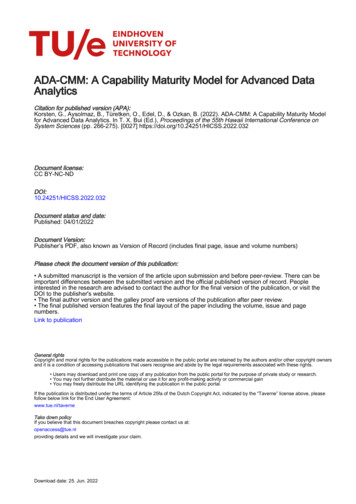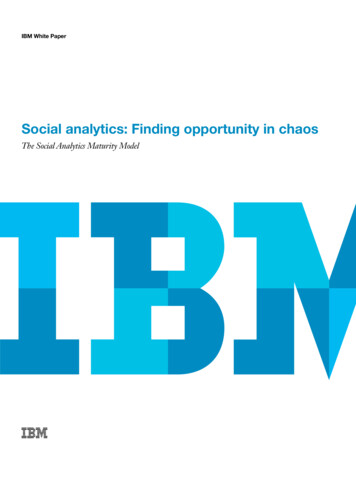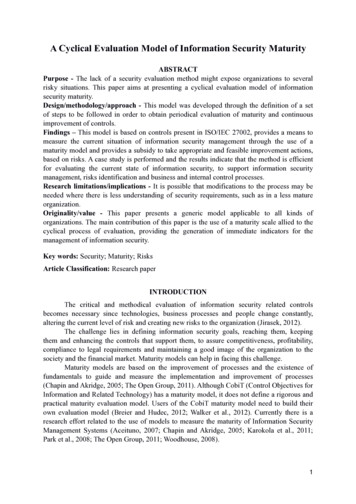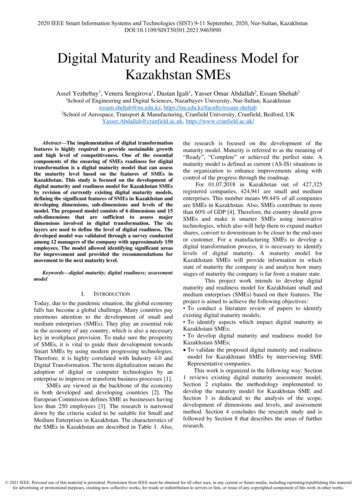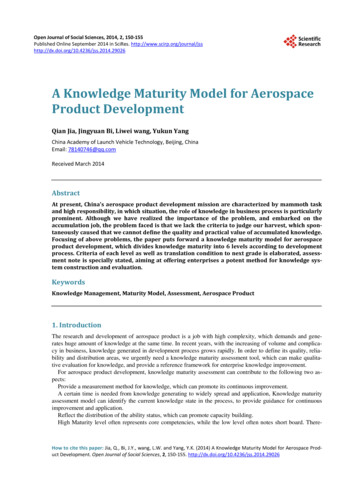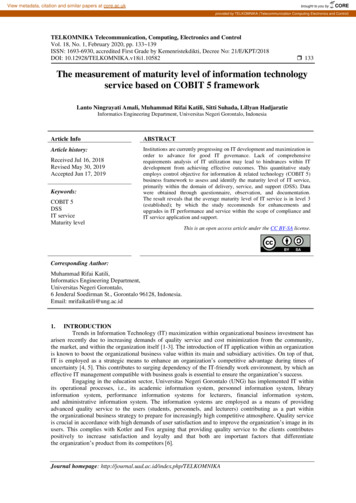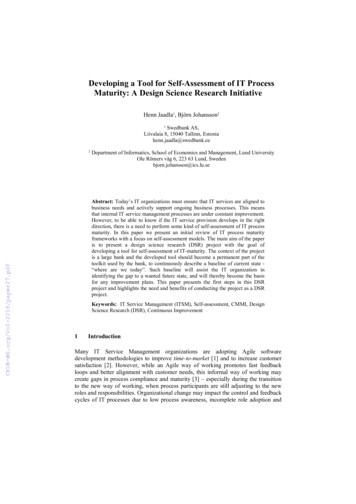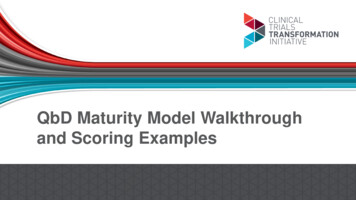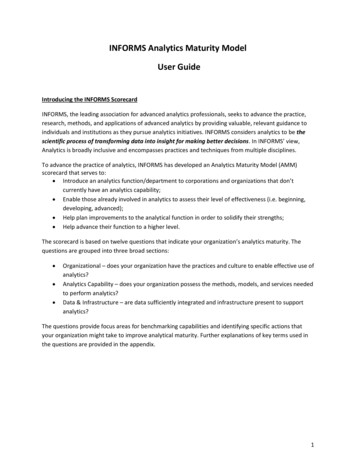
Transcription
INFORMS Analytics Maturity ModelUser GuideIntroducing the INFORMS ScorecardINFORMS, the leading association for advanced analytics professionals, seeks to advance the practice,research, methods, and applications of advanced analytics by providing valuable, relevant guidance toindividuals and institutions as they pursue analytics initiatives. INFORMS considers analytics to be thescientific process of transforming data into insight for making better decisions. In INFORMS’ view,Analytics is broadly inclusive and encompasses practices and techniques from multiple disciplines.To advance the practice of analytics, INFORMS has developed an Analytics Maturity Model (AMM)scorecard that serves to: Introduce an analytics function/department to corporations and organizations that don’tcurrently have an analytics capability; Enable those already involved in analytics to assess their level of effectiveness (i.e. beginning,developing, advanced); Help plan improvements to the analytical function in order to solidify their strengths; Help advance their function to a higher level.The scorecard is based on twelve questions that indicate your organization’s analytics maturity. Thequestions are grouped into three broad sections: Organizational – does your organization have the practices and culture to enable effective use ofanalytics?Analytics Capability – does your organization possess the methods, models, and services neededto perform analytics?Data & Infrastructure – are data sufficiently integrated and infrastructure present to supportanalytics?The questions provide focus areas for benchmarking capabilities and identifying specific actions thatyour organization might take to improve analytical maturity. Further explanations of key terms used inthe questions are provided in the appendix.1
The scorecard questions are focused as shown below:Organizational QuestionsPeopleLeadership ImpactMeasuresProcessesFocuses on awareness and acceptance of the use of analytics by employees tosupport their job/roles within the organization.Focuses on the level of support and commitment by those in leadershippositions.Focuses on analytics-based metrics that drive decision making.Focuses on the use of analytics within processes and activities such as productdesign, manufacturing, sales and marketing, R&D, etc.Analytics Capability QuestionsAnalyticsGovernanceRoles and SkillsAnalytic ServicesAnalytic ProcessesFocuses on how well the organization has defined and documented an approachfor making decisions, and if it is optimized to support key operational orinvestment decisions that provide value.Focuses on the analytic talent that the organization has on hand and how thedepth and breadth of talent is being managed.Focuses on the analytical spectrum (descriptive, predictive, prescriptive models)and the breadth and depth of techniques used.Focuses on identification of the analytical processes that support businessprocesses and how well they are standardized and integrated across theorganization.Data & Infrastructure tureFocuses on quality of the organization’s data, and the adoption of data qualitymanagement practices.Focuses on ability of employees at all levels of the organization to get the datathey need for use in their day-to-day activities. The range of formats and accessspeed would be important considerations.Focuses on the ability of an organization to trace from data to decisions, throughthe use of Master Data Management and Lifecycle Management practices.Focuses on the degree to which the Enterprise Architecture considers analyticalcapabilities and the pervasiveness, variety, and access modes of the capabilitiesprovided.2
Using the ScorecardYou can choose to use either ‘Quick’ or ‘Full’ assessment depth. The ‘Full’ option enables goal setting,and provides links to services that are relevant to your assessment results.3
The scorecard is presented one question at a time. An example question is shown below:Below the answers, the scorecard provides a scale where you can click on the scale value thatrepresents your organization’s current or “As-Is” state. Further space is available to provide rationalebehind the chosen score, and any additional notes.If you selected the ‘Full’ assessment option, a second part of the question provides an option to set anincremental goal within a realistic time period. You can click on the scale value to establish the goallevel, and optionally provide a date and action plan for achievement. If desired, you can also opt out ofsetting any or all goals by checking the ‘skip factor’ box.4
An example goal setting is shown below:Click ‘Continue’ to advance to the remaining questions.5
After all four questions for the section are completed, the scorecard displays a section summary, asshown here:6
After completing the assessment, the scorecard presents an overall summary, as shown here:You have the option to ‘Save’ or ‘Cancel’ the assessment. If saved, you will be able to monitor progressover time as future assessments are made.7
What Next?After completing the assessment, you’ll find a set of links that describe ways that INFORMS can help youachieve your goals.8
9
Appendix: Key Terms ExplainedCenter of Analytical Excellence – a facility or organizational entity providing leadership, practices, andtechnology covering a wide range of analytics capabilities and application areas.Certified professional – an individual with the INFORMS Certified Analytics Professional or similarcredential.Descriptive analytics – methods, largely from the fields of statistics and visualization, that summarize aset of data in a quantitative or graphical way, indicating similarities, differences, or logical groupings, ortrends. Examples include: a clustering analysis to find groupings of customers likely to behave in similarways; a correlation analysis or graph to portray how the values of two or more factors may movetogether.Predictive analytics – the use of techniques from statistics, data mining and machine learning disciplines,to predict a quantity or group membership or future state of entities of interest. Examples include: theuse of logistics regression or classification trees to classify telecom customers into those likely to churnor not (i.e. discontinue service); use of neural networks to predict the likely outcome of a medicalprocedure.Prescriptive analytics – methods that may combine techniques from operations research and otherdisciplines to achieve an “optimal” solution to a complex quantitative problem. Examples include: theuse of optimization algorithms to produce a schedule for employees and/or other resources; the use ofmachine learning algorithms to automate a loan approval process.Data Quality Management – practices and methods focusing on all of the quality-related attributes ofdata and providing processes and tools to ensure that quality goals are met.Master Data Management – an approach consisting of standards, processes, and tools to help ensurethat a single version of master data (the principal entities) is maintained and accessible.Lifecycle Management – an approach to managing data, software, systems, models, documents, etc.that tracks and provides visibility from inception through end of service life.10
to advance the practice of analytics, informs has developed an analytics maturity model (amm) scorecard that serves to: introduce an analytics function/department to corporations and organizations that don't currently have an analytics capability; enable those already involved in analytics to assess their level of effectiveness (i.e.
